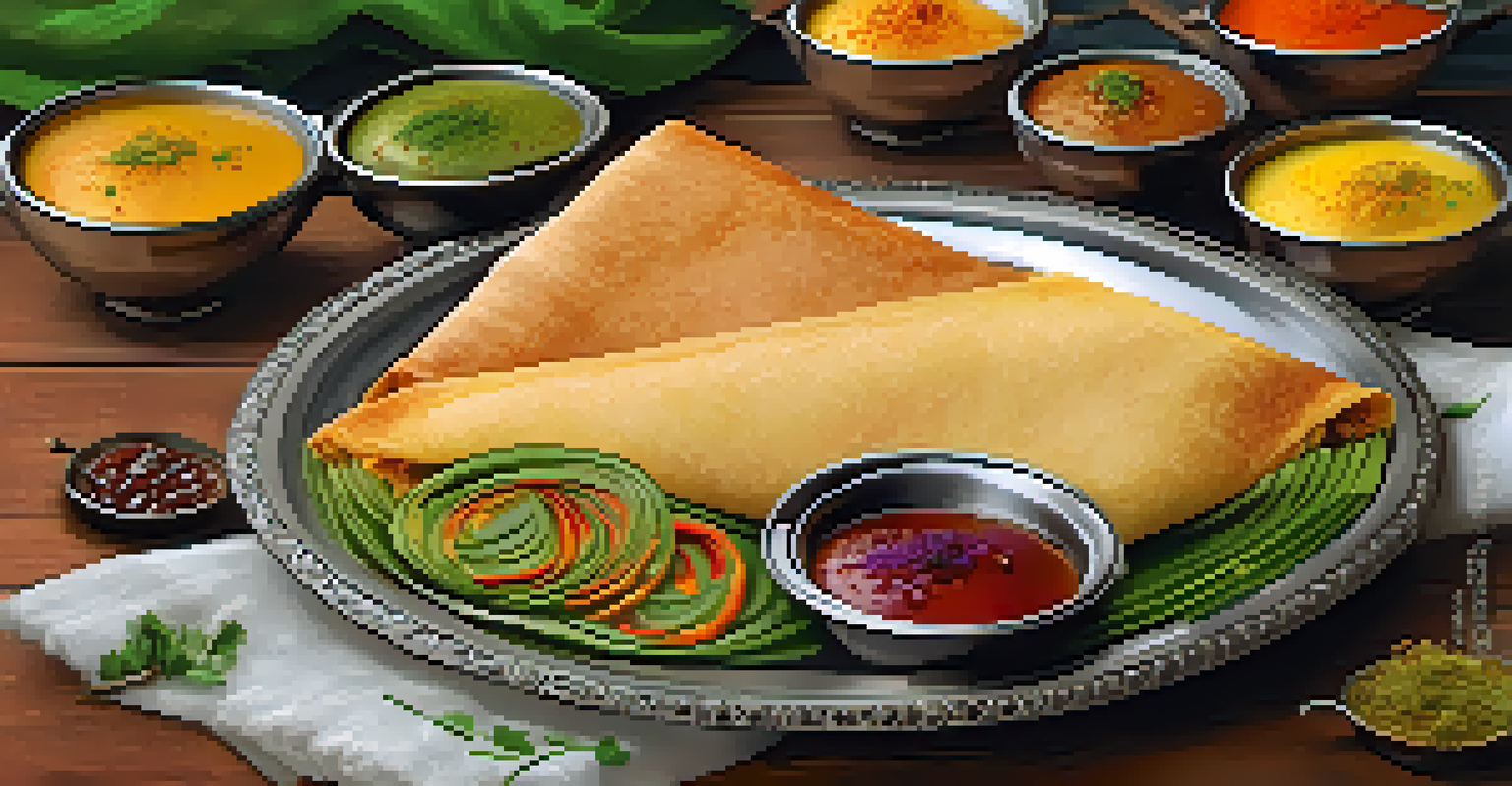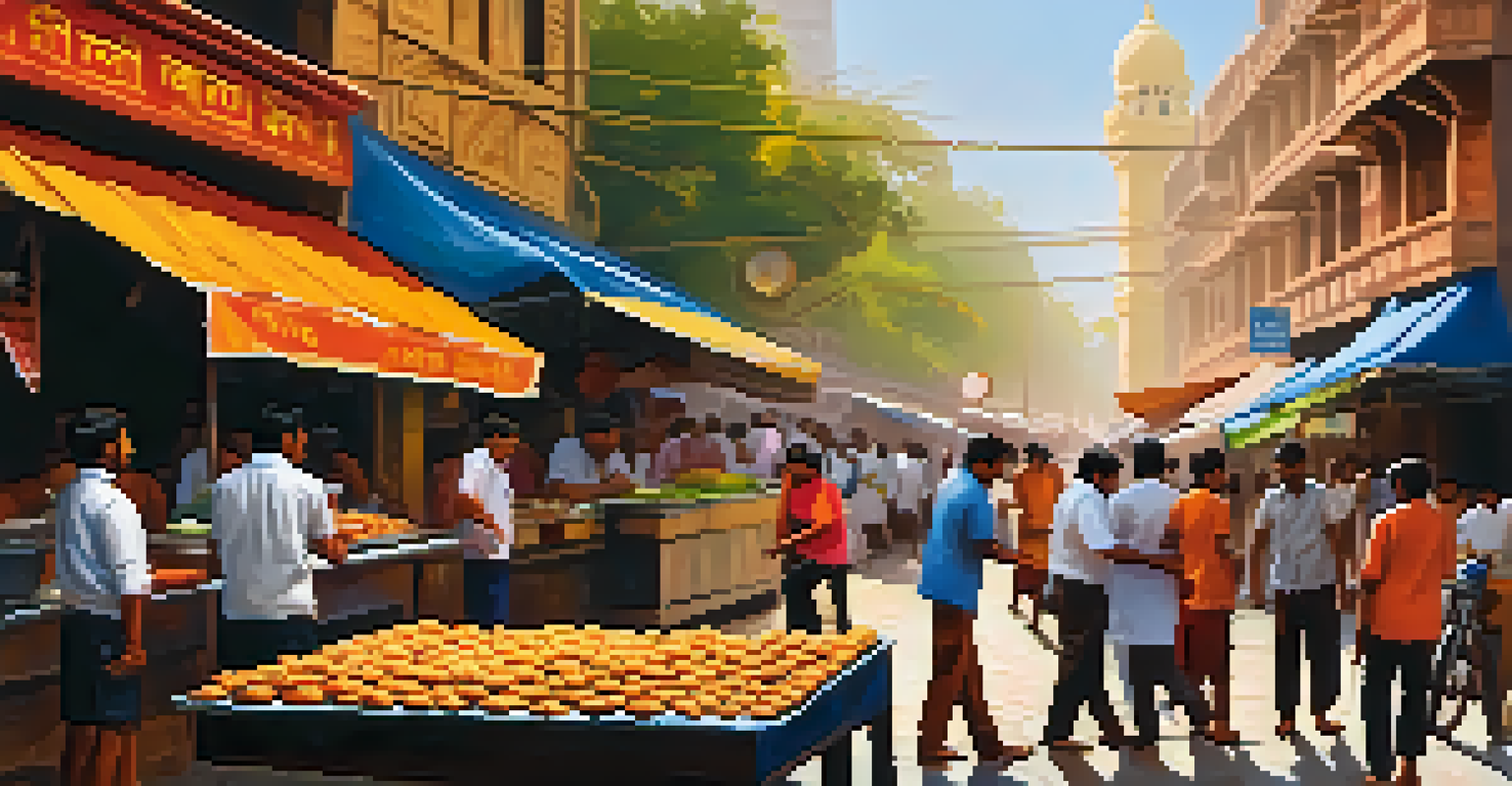Street Food Stories: India's Best Vendors and Their Dishes

The Heartbeat of India: Street Food Culture
Street food in India is more than just a meal; it's a vibrant part of the country's culture and daily life. From bustling markets to lively street corners, these vendors bring communities together with their delicious offerings. Each dish tells a story, often rooted in local traditions and ingredients that reflect the region's heritage.
Food is not just what we eat; it’s how we connect with others, how we share our culture, and how we celebrate life.
Imagine walking through a busy street, the aroma of spices fills the air, and you hear laughter and chatter all around. This scene is a typical day in India, where food stalls serve as social hubs, creating connections among people from all walks of life. The vendors not only offer food but also a slice of the culture that is uniquely Indian.
Street food vendors often start their day before dawn, preparing fresh ingredients and cooking with passion. Their dedication is evident in every bite, making street food an experience that goes beyond taste; it’s about savoring a moment in time.
Chaat: A Flavor Explosion from North India
Chaat is perhaps one of the most beloved street foods in India, especially in the northern regions. With its delightful mix of flavors and textures, it tantalizes the taste buds like no other dish. From the tangy tamarind chutney to the crunchy sev, each component comes together to create a mouthwatering experience.

Popular variations like Pani Puri, Bhel Puri, and Dahi Puri highlight the creativity of street vendors. Each vendor often adds their unique twist, making every chaat experience distinct. It's not just about eating; it's about discovering the artistry behind each dish as you explore different stalls.
Street Food: A Cultural Experience
Street food in India serves as a vibrant cultural hub, bringing communities together through delicious offerings that reflect local traditions.
Chaat is also a great example of India's ability to blend tastes, showcasing sweet, sour, spicy, and savory elements in one bowl. This culinary diversity is a testament to the rich tapestry of flavors that define Indian cuisine.
Vada Pav: The Iconic Mumbai Burger
In the bustling streets of Mumbai, Vada Pav reigns supreme as the ultimate comfort food. This simple yet satisfying dish consists of a spicy potato fritter (vada) sandwiched between a soft bun (pav), often accompanied by chutneys and fried green chilies. A quick bite of Vada Pav offers a burst of flavor that makes it a favorite among locals.
Street food is the best way to experience a city’s culture, with each bite telling a story of its own.
What makes Vada Pav special is its accessibility; you can find it in every nook and cranny of the city—from street corners to bustling train stations. Each vendor may have their signature style, adding to the charm of this beloved snack. It’s the kind of food that fuels you as you navigate the vibrant chaos of Mumbai.
Beyond just being tasty, Vada Pav also symbolizes the spirit of Mumbai—resilient and ever-evolving. It’s a dish that has transcended time, and like the city itself, it continues to adapt while remaining a classic staple.
Dosa: A South Indian Delight
Dosa, a thin and crispy crepe made from fermented rice and lentil batter, is a staple of South Indian cuisine. Vendors often serve it with a variety of chutneys and sambar, creating a delightful balance of flavors. The aroma of a dosa cooking on a hot griddle is enough to draw anyone in from the street.
What makes dosa even more exciting is the array of fillings available. From spicy potato masala to cheese and even chocolate, there’s a dosa for everyone. This versatility not only appeals to the palate but also showcases the creativity of street food vendors across the South.
Diverse Flavors of Indian Chaat
Chaat showcases India's culinary creativity, blending sweet, sour, spicy, and savory elements into a delightful and unique dining experience.
Eating dosa is more than just a meal; it's a communal experience. Often enjoyed at breakfast or as a snack, sharing a plate of crispy dosas with friends or family is a cherished tradition that brings people together.
Pav Bhaji: A Spicy Vegetable Mash
Pav Bhaji is a beloved street food that originated in Mumbai, and it quickly gained popularity across India. This dish features a spicy vegetable mash served with buttered pav (bread rolls), making it a hearty and delicious meal. The combination of flavors, along with the generous dollops of butter, makes it a comforting choice for many.
Vendors typically prepare pav bhaji on a massive griddle, showcasing their skill as they mix the vegetables and spices to perfection. The vibrant colors of the dish and the aroma wafting through the air are irresistible. Each vendor adds their unique touch, so no two servings are exactly the same.
Pav Bhaji is more than just food; it’s a social experience. Whether enjoyed at a roadside stall or during a family gathering, it fosters a sense of community among those who share it, turning a simple meal into a memorable event.
Kathi Rolls: A Portable Feast
Kathi Rolls, originating from Kolkata, are a delicious and portable snack that has taken India by storm. These wraps typically feature skewered and grilled meat or vegetables, all rolled up in a paratha with chutneys and onions. Their convenience makes them a favorite among busy city dwellers looking for a quick yet satisfying meal.
What sets Kathi Rolls apart is the variety of fillings and sauces available, making each roll customizable to your taste. Whether you prefer chicken, paneer, or mixed vegetables, there’s a Kathi Roll for everyone. This versatility has broadened their appeal, allowing them to transcend regional boundaries.
Sweets: A Sweet Conclusion
Indian street desserts like Jalebi and Rabri not only satisfy cravings but also highlight the cultural significance of sharing and celebration in everyday life.
Moreover, Kathi Rolls symbolize the fusion of flavors and cultures that is so prevalent in Indian street food. They embody the spirit of innovation, as vendors continually experiment with new ingredients and recipes, ensuring that each bite is a delightful surprise.
The Sweet Side: Jalebi and Other Desserts
No street food journey in India is complete without indulging in some sweets, and Jalebi is a must-try. This deep-fried, spiral-shaped treat is soaked in sugar syrup, creating a crispy exterior and a sweet, gooey interior. Vendors often serve it hot, making it an irresistible delight for anyone with a sweet tooth.
Jalebi is just the tip of the iceberg when it comes to Indian street desserts. From the creamy richness of Rabri to the fragrant, syrup-soaked Gulab Jamun, each dessert tells a different story of Indian culinary traditions. Street vendors take pride in their sweets, crafting them with care and often using family recipes passed down through generations.

These desserts not only satisfy cravings but also provide a glimpse into the culture of sharing and celebration in India. Whether enjoyed at a festival or as an everyday treat, sweets hold a special place in the hearts of many, making every street food experience wholesome and complete.
Savoring the Experience: More than Just Food
At the end of the day, street food is about more than just the dishes; it’s about the experience. The sights, sounds, and smells create a vibrant atmosphere that draws people in. Eating street food is a sensory journey that allows you to connect with India’s rich culture and diverse communities.
Every vendor has their unique story, often reflecting their journey, passion, and craft. As you savor each bite, you’re not just tasting food; you’re participating in a living tradition that has been passed down through generations. This connection to the vendors and their stories adds depth to the street food experience.
So, the next time you find yourself in India, don’t just grab a bite on the go; take a moment to appreciate the artistry and community behind the food. Street food isn't just a meal; it's a celebration of life, culture, and the shared joy of eating together.